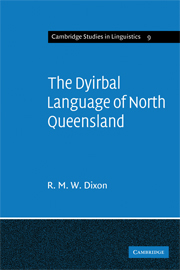Book contents
- Frontmatter
- Contents
- List of maps and plates
- Acknowledgements
- Preface
- Abbreviations and conventions
- 1 AUSTRALIAN LANGUAGES
- 2 DYIRBAL: THE LANGUAGE AND ITS SPEAKERS
- 3 WORD CLASSES
- 4 SYNTAX
- 5 DEEP SYNTAX
- 6 MORPHOLOGY
- 7 PHONOLOGY
- 8 SEMANTICS
- 9 LEXICON
- 10 PREHISTORY
- APPENDIX A DYIRBAL LOGIC
- APPENDIX B PREVIOUS WORK ON DYIRBAL
- TEXTS
- VOCABULARY
- LIST OF DYIRBAL AFFIXES
- REFERENCES
- INDEX OF AUSTRALIAN LANGUAGES
- Plate section
- Frontmatter
- Contents
- List of maps and plates
- Acknowledgements
- Preface
- Abbreviations and conventions
- 1 AUSTRALIAN LANGUAGES
- 2 DYIRBAL: THE LANGUAGE AND ITS SPEAKERS
- 3 WORD CLASSES
- 4 SYNTAX
- 5 DEEP SYNTAX
- 6 MORPHOLOGY
- 7 PHONOLOGY
- 8 SEMANTICS
- 9 LEXICON
- 10 PREHISTORY
- APPENDIX A DYIRBAL LOGIC
- APPENDIX B PREVIOUS WORK ON DYIRBAL
- TEXTS
- VOCABULARY
- LIST OF DYIRBAL AFFIXES
- REFERENCES
- INDEX OF AUSTRALIAN LANGUAGES
- Plate section
Summary
A full account of the semantics of Dyirbal would be considerably more lengthy than the description of the grammar and phonology, in chapters 3–7. In this chapter we refer briefly to some of the main points of Dyirbal semantics, paying attention to aspects that reinforce and help to explain parts of the syntax. A complete account of the semantics, in the form of a comprehensive dictionary-thesaurus of the language, is in active preparation. A provisional statement of verb semantics, going into considerably more detail than is attempted here, will be found in Dixon [1971].
Guwal-Dyalŋuy correspondences
We mentioned in 2.5 that when a speaker was within earshot of a ‘taboo’ relative he had to use Dyalŋuy, the so-called ‘mother-in-law’ style. In all other circumstances he had to use Guwal, the ‘everyday’ style. Every dialect has its own Guwal and Dyalŋuy. Each Dyalŋuy has identical phonology, and almost exactly the same grammar, as its Guwal. However, it has an entirely different vocabulary, there being not a single lexical item common to the Dyalŋuy and Guwal of a tribe.
Confronted with a Guwal word a speaker will give a unique Dyalŋuy ‘equivalent’. And for any Dyalŋuy word he will give one or more corresponding Guwal words. It thus appears that the two vocabularies are in a one-to-many correspondence: each Dyalŋuy word corresponds to one or more Guwal words (and the words so related are in almost all cases not cognate with each other).
- Type
- Chapter
- Information
- The Dyirbal Language of North Queensland , pp. 292 - 313Publisher: Cambridge University PressPrint publication year: 1972



